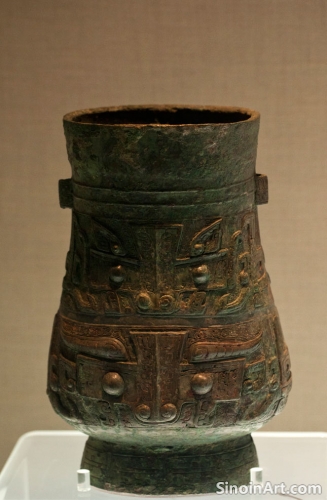Bronze Ware and Ancient Chinese Textile Production: Spindle Whorls, Weaving Tools, and Textile Art
|
While bronze is not a textile material, it played a significant role in the production of ancient Chinese fabrics, used in the creation of spindle whorls, weaving tools, and other components, which were vital for textile creation, and also in the creation of decorative elements that were incorporated into the textile designs. This interplay between different arts and crafts reflects the creativity and skills of ancient Chinese craftspeople. The blending of different materials helped to create new and innovative textile traditions.  Bronze spindle whorls, used to spin yarn and thread, were carefully designed to provide the proper weight and balance for optimal performance. The careful design of these pieces helped to enhance the speed and effectiveness of the textile production process.  Bronze was also used in the creation of weaving tools, including shuttles, hooks, and heddle components, which were used to create a variety of intricate fabric patterns and weaves. The use of these specialized tools helped to broaden the range and scope of textile production. The careful crafting of these tools is also a testament to the skill of ancient Chinese metalworkers.  Bronze was also used in the creation of decorative elements for clothing and textiles, including belt hooks, buckles, and clasps, allowing for a greater degree of visual complexity and personal style. The integration of metalwork into textile design added a touch of luxury and sophistication to ancient Chinese clothing. The study of bronze in the context of textile production reveals the complexity and sophistication of ancient Chinese crafts, and also highlights the importance of interdisciplinary innovation and the way in which different fields of knowledge and creative expression have overlapped and interacted. The combination of bronze and textile production also demonstrates the interconnected nature of daily life and artistic expression in ancient China. |
Tag : bronze textile tools, Chinese weaving, spindle whorls, textile art, ancient crafts
Related information
- The Use of Bronze in Ancient Chinese Water Clocks and Timekeeping Devices
- The Use of Bronze in Ancient Chinese Maritime Activities: Vessels and Tools
- The Evolution of Bronze Bell Design in China: From Simple Forms to Complex Chimes
- Bronze Ware and the Development of Ancient Chinese Trade Practices: Routes, Markets, and Exchange
- The Legacy of Chinese Bronze Ware: Its Influence on Later Art Forms
This article explores the use of bronze in ancient Chinese water clocks and other timekeeping devices, highlighting their complex mechanisms, their integration of astronomical data, and their importance in standardizing time measurement for a variety of purposes.
This article explores the use of bronze in ancient Chinese maritime activities, highlighting its role in ship construction, the creation of navigational and fishing tools, and its contribution to the development of trade and exploration.
This article explores the evolution of bronze bell design in China, highlighting the transition from simple bells to complex bianzhong chimes, the development of tuning techniques, and their significance in both music and ritual.
This article explores the role of bronze ware in the development of ancient Chinese trade practices, highlighting the emergence of trade routes, markets, and systems of exchange, and revealing its economic, social, and cultural impact.
This article explores the enduring legacy of Chinese bronze ware, highlighting its influence on later forms of Chinese art, including ceramics, painting, and sculpture, with particular emphasis on the enduring impact of bronze forms, motifs, and aesthetic principles.